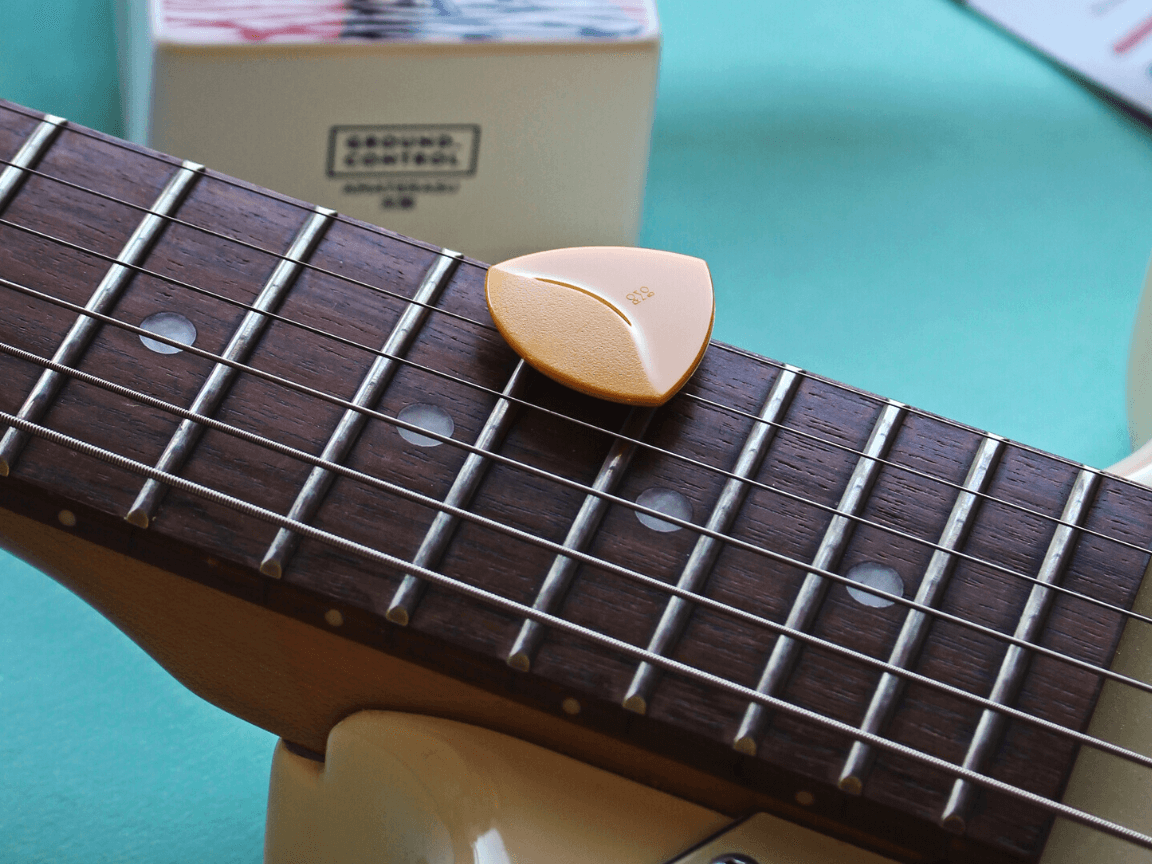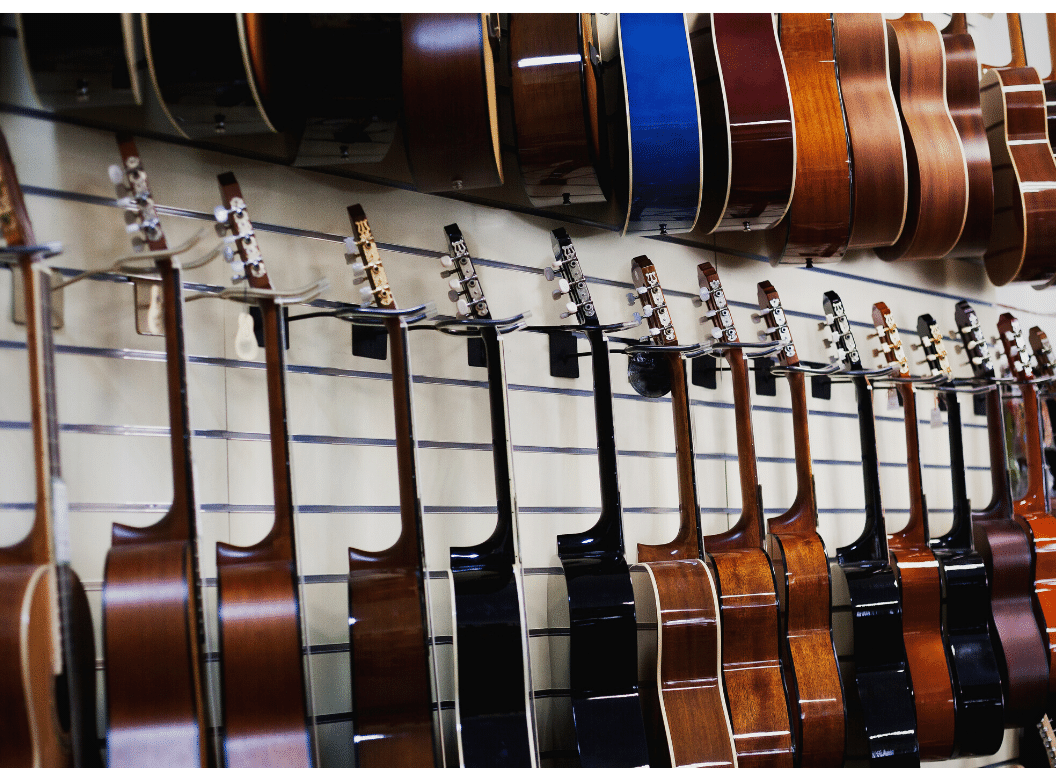If you’re a beginner guitarist, you may be wondering if guitar picks are a good choice for you.
You see everybody playing with them, and after all, they’re an essential part of playing the guitar, so it’s important to get it right.
In this article, we’ll discuss the benefits of using guitar picks for beginners, as well as the types of picks available, and how to choose the right one for your needs.
We’ll also cover some tips for using guitar picks to get the most out of your playing and talk about whether or not you should start playing with them or not.
Whether you’re a complete beginner or oven someone who has never played with picks before, you’ll surely find something useful in this article.
So, let’s dive in and explore the world of guitar picks!
Table of Contents
- Are guitar picks good for beginners?
- Benefits of Using a Guitar Pick for Beginners
- Different Types of Guitar Picks
- How to choose the right guitar pick?
- How to properly hold a guitar pick?
- When should you stop using a guitar pick?
- Which guitar pick is best for beginners?
- Is it easier to strum with a pick?
- Is picking harder than strumming?
- Should I learn to play fingerstyle or use a pick?
- Do all guitarists use picks?
- How do guitar picks affect tone?
- Final thoughts
Are guitar picks good for beginners?
Yes, guitar picks can be a great tool for beginners since they help to create a clean, consistent sound and can make learning chords and strumming patterns easier. Now, it’s important to note that using your thumb or fingers to strum chords and notes is also a great way to play, so it’s really up to you which approach you’d like to take. Learning both techniques seems to be the most efficient way.
If you decide to use guitar picks, it’s important to choose the right one.
Different types of picks are available, each with its own unique characteristics and sound.
On top of that, there are also different sizes, shapes, and thicknesses of picks to choose from.
To make sure you get the right one for your playing style, it’s important to consider all of these factors in order to find the perfect fit.
Benefits of Using a Guitar Pick for Beginners
Even though some people think that beginners won’t see any benefit from using a guitar pick, the truth is that it can be an incredibly helpful tool.
Let’s take a look at some of the key benefits of using a guitar pick for beginners:
1. Enhanced Tone
Using a guitar pick can help to bring out the nuances in certain notes, allowing beginners to play with greater depth and range.
Even if you’re just strumming chords, a pick will add clarity and resonance to each note.
This happens because the pick gives it a better attack, providing a more distinct sound that would otherwise be lost when strumming without a pick.
Also, the type of pick you choose can also affect the tone and sound of your guitar.
For example, a harder plastic pick will give a sharper attack to notes, while softer picks tend to produce warmer tones.
I’ll take a look at some different pick materials later in this article.
2. Improved Accuracy
Using a guitar pick is a great way for beginners to improve their playing and accuracy.
By using a pick, you’re able to attack the strings with greater precision, which can help make it easier to play specific notes on the guitar.
This level of accuracy is especially important when playing lead guitar solos or intricate melodies.
Additionally, some people can find it hard to play a single string without accidentally hitting adjacent strings.
Using a pick can help to reduce this problem because it gives you greater control over what strings are being strummed and which ones aren’t.
3. Easier Strumming
Additionally, a guitar pick can help with strumming, as it makes it easier to control the speed and intensity of each strum.
This can be especially helpful for strumming chords, as it allows beginners to get a better feel for the rhythm and groove of each song.
Even though strumming with your fingers provides way more points of contact with the strings, using a pick can be simpler and more effective in the early stages of learning.
On top of that, it can also be a great way to develop your strumming technique, as you’ll need to adjust the pick angle and pressure depending on what type of sound you’re trying to achieve.
4. Faster Progress
Using a guitar pick can help beginners make faster progress, as it allows them to play with more clarity and accuracy than if they were strumming with their fingers.
With a pick, you’ll be able to practice more complex chords and techniques in less time and with greater precision, which will help you quickly build up your guitar-playing skills.
In other words, you will be able to pay more attention to other aspects of your playing like rhythm, timing, and dynamics.
Your fretting hand will also thank you, as you will subside some of the fatigue that comes with playing complex chords by paying extra attention to having good technique.
Different Types of Guitar Picks
When it comes to guitar picks, there are many different types to choose from.
They all have different shapes, sizes, materials, and thicknesses that cater to different playing styles.
Some of the most common types of guitar picks include:
- Celluloid – The classic pick material; lightweight and produces a brighter sound.
- Nylon or Delrin – These plastic picks are available in both thicker (jazz pick) and thinner (standard pick) sizes. They are known for their durability and bright, articulate tone.
- Acetal – A slightly softer material than nylon or Delrin; these picks produce a warm sound with plenty of attacks.
- Metal – These heavy-gauge picks create a full, thick sound that’s great for strumming.
- Composite – A combination of different materials, such as nylon and metal. These picks tend to be slightly heavier than standard plastic ones but still provide a balanced tone.
Let’s take a closer look at the different shapes and sizes of guitar picks
1. Shape
The shape of the pick is one of the most important factors to consider, as it can affect the sound of the guitar.
Common shapes include teardrop, triangle, jazz, and standard.
The teardrop shape is popular for its comfort and control, while the triangle shape gives a bright, articulate sound.
The jazz pick is thicker than the standard pick and produces a fat, warm tone that’s perfect for, well, jazz.
The standard shape is the most popular and versatile pick, great for rock and other genres, and is usually made of plastic and preferred by beginners.
2. Size
The size of the guitar pick also affects the sound and feel of the instrument.
Large picks provide more control, while small picks produce a lighter, more responsive tone.
On the other hand, thicker picks tend to create a fuller sound and have more attack.
I personally prefer the medium thickness of a standard pick, as it gives me control and flexibility.
You kinda get the best of both worlds with a medium-thickness pick.
It won’t be too light, but it won’t be too heavy either, and it will give you a balanced and articulate sound.
2. Material
The material of the pick is also important, as different materials can produce different tones.
Common materials include celluloid, nylon, metal, plastic, and even wood.
Celluloid is the classic pick material and provides a bright, articulate sound.
On the other hand, Nylon or Delrin picks are durable and also produce a bright tone that’s not too overpowering.
Metal picks are heavier and create a fuller sound, while plastic picks provide a balanced tone that’s great for strumming.
Finally, wooden picks can produce a warm, mellow tone with plenty of attack, these picks tend to be more expensive than plastic and metal but having one or two can really add some character to your playing.
3. Thickness
Lastly, the thickness of the pick is important, as it can affect the attack and clarity of the sound.
Thinner picks are great for strumming and allow you to play faster since they bend more easily and let you move your hand around the strings quickly.
Thicker picks are more rigid and create a fuller sound with more attack.
Common thicknesses range from 0.38mm to 2.00mm.
They are best for fingerpicking, as they provide greater control over the strings and give you more precision.
As I said before, I personally prefer medium-thickness picks which would have around 0.73mm–1.14mm.
How to choose the right guitar pick?
With so many different types of guitar picks available, you might be wondering which one is right for you.
Here are some tips to help you choose the best guitar pick:
1. Think about the type of music you want to play
Choosing the right guitar pick can make a big difference in your sound and playing style.
Depending on the type of music you are playing, the type of guitar you are playing, and the size of your hands, there are different types of picks that may be better suited for you.
When considering the type of music you are playing, it’s important to think about the sound you want to achieve.
For example, if you’re playing rock or metal, a thicker pick will give you more attack and clarity, while a thinner pick will give you a softer, warmer sound.
If you’re playing jazz or blues, a thinner pick will give you a more mellow sound that’s very suited to those styles.
On the other hand, if you’re playing acoustic music, a medium-thickness pick may be your best bet.
This is because it gives you enough attack to cut through the mix, but it also has a softer sound that won’t overpower the other instruments.
2. Consider the guitar type you’re thinking of having
The type of guitar you’re playing is also important when choosing the right pick.
Acoustic guitars require a thicker pick for more attack and volume, while electric guitars require a thinner pick for a softer, more subtle sound.
This doesn’t mean that you can’t use a thicker pick on an electric guitar, but it’s important to consider how the different thicknesses of picks will affect your sound.
Also, will you play lead or rhythm?
If you’re playing lead, a thin pick is usually best as it will give you more control and accuracy.
But, if you’re playing rhythm, then a thicker pick may be better as it will provide more attack and clarity in your sound.
3. Be aware of the size of your hands
If you have large hands, a thicker pick may be more comfortable for you to hold and play with.
Now, if you have smaller hands, though, a thinner pick may be easier to control since it will be lighter and smaller.
Additionally, if you’re a beginner, then it may be best to start with a medium-thickness pick as this will provide more control and accuracy.
Usually, as you become more experienced and comfortable with playing, you may want to experiment with different thicknesses of picks to find the best one for your style.
How to properly hold a guitar pick?
Holding a guitar pick correctly is important for any guitarist.
A proper technique not only helps you sound better but can also help protect your hands and fingernails from injury.
Let’s take a look at some basic tips to help you get started:
1. Positioning the pick
Holding a guitar pick properly is an important part of playing the guitar.
Even though it might seem like a small detail, it can make a big difference in how you play.
The pick should be held between your thumb and index finger with the point of the pick facing downward.
Make sure to keep your hand relaxed and avoid gripping the pick too tightly.
When positioning the pick, it’s important to make sure that the pick is held between your thumb and index finger.
You should place the pick near the tip of your index finger, and make sure that your thumb is slightly curved.
This will give you the most control over the pick and help you avoid straining your hand.
2. Angling the pick the right way
The angle at which you hold your pick will affect how well you can control it and the sound of your playing.
When angling the pick, make sure to tilt it slightly toward the strings.
This will help you to produce a fuller sound when strumming.
And it will also make it easier to move the pick between strings quickly and accurately.
What this does is that in a way, prevents your pick from getting stuck between the strings, which tends to happen more when you hold the pick flat.
3. Gripping the pick
When gripping the pick, you want to make sure that your thumb and index finger are slightly curved and that the pick is held firmly.
You don’t want to grip the pick too tightly, as this can cause your hand to become tired quickly and affect the sound of your playing.
The key is to find a balance between holding the pick firmly and keeping your hand relaxed.
With time and practice, you’ll be able to adjust your grip to suit different playing styles and techniques.
You also don’t want to hold the pick too loosely, as this can cause the pick to slip out of your hand while you’re playing.
On top of that, your wrist should be slightly bent and relaxed to ensure maximum control over the pick.
But remember, not so much that it looks strained and uncomfortable.
When should you stop using a guitar pick?
When it comes to using a guitar pick, there is no definitive answer as to when you should stop using one.
Ultimately, it comes down to personal preference and playing style.
If you feel that you have a good handle on the basics of playing with a pick, you may want to consider experimenting with other techniques such as fingerpicking or using a hybrid picking technique.
However, if you find that you prefer the sound and feel of playing with a pick, then there is no reason to stop using one.
Ultimately, the decision is yours, so experiment and find what works best for you and your playing style.
Which guitar pick is best for beginners?
When it comes to choosing the best guitar pick for beginners, it really depends on the type of sound you’re looking for and the type of guitar you’re playing.
Generally, a medium-gauge pick is a good starting point, as it provides a good balance between strumming and picking.
If you’re playing an acoustic guitar, a medium-gauge pick is usually the way to go, as it will provide a good balance between strumming and picking.
If you’re playing an electric guitar, you may want to try a slightly thicker pick, as it will provide a bit more attack and clarity.
Ultimately, the best guitar pick for beginners is one that feels comfortable in your hand and produces the sound you’re looking for.
Experiment with different picks and find the one that works best for you!
Is it easier to strum with a pick?
It depends on the individual and their preference.
Generally speaking, strumming with a pick is easier than strumming with your fingers.
A pick allows for more control over the strings and makes it easier to play faster and more accurately.

It also helps to keep the strings from buzzing and produces a more consistent sound.
On the other hand, strumming with your fingers can produce a warmer, more organic tone.
It also gives you more control over the dynamics of your playing.
Ultimately, it comes down to what feels most comfortable and natural to you.
Experiment with both and see which one works best for you.
Is picking harder than strumming?
When it comes to playing the guitar, picking and strumming are two very different techniques.
Picking is when you use your fingers or a pick to pluck individual strings, while strumming is when you use a sweeping motion of your hand or a pick to play multiple strings at once.
Whether one is harder than the other is a matter of opinion, as it largely depends on the individual’s skill level and preferences.

Generally speaking, picking can be more difficult to master, as it requires precise finger placement and control.
Strumming, on the other hand, is more of a rhythmic technique and doesn’t require as much precision.
However, it can be difficult to master the timing and coordination needed to strum in a consistent and even manner.
Ultimately, both techniques are important for any guitarist to learn and practice, and the difficulty of each will vary from person to person.
Should I learn to play fingerstyle or use a pick?
It really depends on what type of music you want to play.
If you want to play songs that require intricate melodies and complex chords, then learning to play fingerstyle is probably the way to go.
Fingerstyle allows you to play multiple notes simultaneously and gives you the ability to create a more intricate sound.

However, if you’re looking for a more aggressive sound, then using a pick is probably the way to go.
Playing with a pick gives you more control over the attack of the notes and allows you to play faster and more aggressively.
Ultimately, it comes down to personal preference and the type of music you want to play.
If you’re just starting out, it’s a good idea to experiment with both techniques and see which one you prefer.
Do all guitarists use picks?
No, not all guitarists use picks.
While many guitarists do use picks, there are some that prefer to play without them.
Some guitarists prefer to use their fingers to pluck the strings, while others use a combination of their fingers and a pick.

Some guitarists also use a pick and their thumb to strum the strings.
It all comes down to personal preference and what sounds best to the individual.
Some guitarists may use a pick for certain songs or genres, but not for others.
It’s important to experiment with different techniques to find the one that works best for you.
How do guitar picks affect tone?
Guitar picks are a small but important factor in the overall tone of a guitar.
They come in a variety of shapes, sizes, and thicknesses, and each one will affect the sound of your guitar in different ways.
Thicker picks produce a fuller, warmer tone, while thinner picks create a brighter, crisper sound.

The material the pick is made from also has an effect on tone; picks made from plastic tend to produce a bright, snappy sound, while picks made from metal or stone create a more aggressive tone.
Finally, the grip of the pick can also affect the tone; picks with a rougher grip tend to produce a more percussive sound, while smoother picks create a more mellow tone.
Ultimately, the choice of pick is up to the individual player, as it can have a significant impact on the sound of the guitar.
Final thoughts
In summary, guitar picks are an essential tool for any guitarist, but especially for beginners.
They are a simple and affordable way to get started on the instrument, and can be used to help develop good technique and sound.
They come in a variety of shapes and sizes, and can be used to create different sounds and textures.
With a little practice, beginners can quickly learn how to use a pick to their advantage, and can take their playing to the next level.
So if you’re looking to get started on the guitar, make sure to grab some picks and get picking!

More than 10 years of experience playing and writing about guitars! When not writing, I can be found strumming away some Johnny Cash tunes. Favorite all time guitar is the Gibson Les Paul. #TeamGibson




